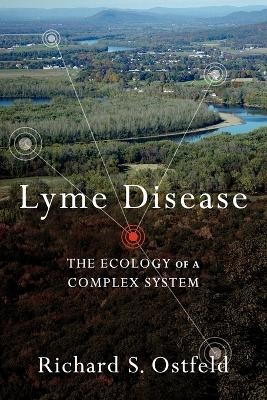
Lyme Disease
The Ecology of a Complex System
Seiten
2012
Oxford University Press Inc (Verlag)
978-0-19-992847-7 (ISBN)
Oxford University Press Inc (Verlag)
978-0-19-992847-7 (ISBN)
The authoritative guide on the ecology and epidemiology of Lyme disease
Most human diseases come from nature, from pathogens that live and breed in non-human animals and are "accidentally" transmitted to us. Human illness is only the culmination of a complex series of interactions among species in their natural habitats. To avoid exposure to these pathogens, we must understand which species are involved, what regulates their abundance, and how they interact.
Lyme disease affects the lives of millions of people in the US, Europe, and Asia. It is the most frequently reported vector-borne disease in the United States; About 20,000 cases have been reported each year over the past five years, and tens of thousands more go unrecognized and unreported. Despite the epidemiological importance of understanding variable LD risk, such pursuit has been slow, indirect, and only partially successful, due in part to an overemphasis on identifying the small subset of 'key players' that contribute to Lyme disease risk, as well as a general misunderstanding of effective treatment options.
This controversial book is a comprehensive, synthetic review of research on the ecology of Lyme disease in North America. It describes how humans get sick, why some years and places are so risky and others not. It challenges dogma - for instance, that risk is closely tied to the abundance of deer - and replaces it with a new understanding that embraces the complexity of species and their interactions. It describes why the place where Lyme disease emerged - coastal New England - set researchers on mistaken pathways. It shows how tiny acorns have enormous impacts on our probability of getting sick, why biodiversity is good for our health, why living next to a small woodlot is dangerous, and why Lyme disease is an excellent model system for understanding many other human and animal diseases. Intended for an audience of professional and student ecologists, epidemiologists, and other health scientists, it is written in an informal style accessible also to non-scientists interested in human health and conservation.
Most human diseases come from nature, from pathogens that live and breed in non-human animals and are "accidentally" transmitted to us. Human illness is only the culmination of a complex series of interactions among species in their natural habitats. To avoid exposure to these pathogens, we must understand which species are involved, what regulates their abundance, and how they interact.
Lyme disease affects the lives of millions of people in the US, Europe, and Asia. It is the most frequently reported vector-borne disease in the United States; About 20,000 cases have been reported each year over the past five years, and tens of thousands more go unrecognized and unreported. Despite the epidemiological importance of understanding variable LD risk, such pursuit has been slow, indirect, and only partially successful, due in part to an overemphasis on identifying the small subset of 'key players' that contribute to Lyme disease risk, as well as a general misunderstanding of effective treatment options.
This controversial book is a comprehensive, synthetic review of research on the ecology of Lyme disease in North America. It describes how humans get sick, why some years and places are so risky and others not. It challenges dogma - for instance, that risk is closely tied to the abundance of deer - and replaces it with a new understanding that embraces the complexity of species and their interactions. It describes why the place where Lyme disease emerged - coastal New England - set researchers on mistaken pathways. It shows how tiny acorns have enormous impacts on our probability of getting sick, why biodiversity is good for our health, why living next to a small woodlot is dangerous, and why Lyme disease is an excellent model system for understanding many other human and animal diseases. Intended for an audience of professional and student ecologists, epidemiologists, and other health scientists, it is written in an informal style accessible also to non-scientists interested in human health and conservation.
Rick Ostfeld is Senior Scientist and Animal Ecologist at the Cary Institute of Ecosystem Studies, Millbrook, New York.
Preface ; Chapter 1 - Introduction ; Chapter 2 - Discovery ; Chapter 3 - It's the deer ; Chapter 4 - It's the mice ; Chapter 5 - It's the Weather ; Chapter 6 - Questioning Dogma ; Chapter 7 - Embracing Complexity: Food Webs ; Chapter 8 - Embracing Complexity: Biodiversity ; Chapter 9 - Embracing Complexity: Ecosystem Functioning ; Chapter 10 - Embracing Complexity: Biocontrol of Ticks and Lyme Disease ; Chapter 11 - In Pursuit of Emerging Infectious Diseases ; Index
| Erscheint lt. Verlag | 26.7.2012 |
|---|---|
| Verlagsort | New York |
| Sprache | englisch |
| Maße | 231 x 155 mm |
| Gewicht | 340 g |
| Themenwelt | Medizin / Pharmazie ► Medizinische Fachgebiete |
| Studium ► Querschnittsbereiche ► Epidemiologie / Med. Biometrie | |
| Naturwissenschaften ► Biologie ► Mikrobiologie / Immunologie | |
| Naturwissenschaften ► Biologie ► Ökologie / Naturschutz | |
| Naturwissenschaften ► Biologie ► Zoologie | |
| ISBN-10 | 0-19-992847-9 / 0199928479 |
| ISBN-13 | 978-0-19-992847-7 / 9780199928477 |
| Zustand | Neuware |
| Haben Sie eine Frage zum Produkt? |
Mehr entdecken
aus dem Bereich
aus dem Bereich
ein überfälliges Gespräch zu einer Pandemie, die nicht die letzte …
Buch | Hardcover (2024)
Ullstein Buchverlage
CHF 34,95


